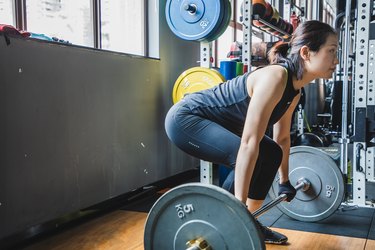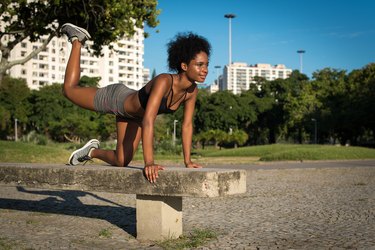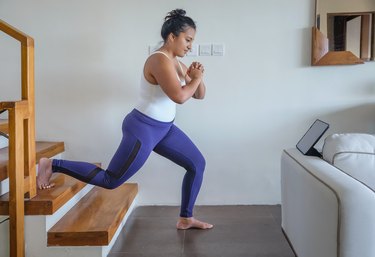
If the derriere of your dreams is firm, round and perky, you can get a toned butt through consistent, targeted butt workouts at home and optimal nutrition. But how long it takes to get a bigger butt will depend on your starting point and how hard you work.
Tip
How long does it take to build a butt? If you're consistent with your workouts, you can start to see results in about 4 to 6 weeks. However, modest muscle growth requires about 6 to 8 weeks of consistent work, and in 6 months to a year, you can change the musculature and body composition of your butt.
Video of the Day
Toned Butt vs. Bigger Butt
"A lot of people think, 'If I work on my butt, my butt's going to get bigger,'" says Holly Perkins, BS, CSCS, creator of The Glutes Project. But, as she explains, that's not always the case. There are two ways to improve your backside and the method you choose depends on your goal.
Toning (think: high and tight) is more a result of muscular endurance, while building a bigger butt (#glutegains) is a product of myofibrillar hypertrophy, a type of muscle growth. But what if fat loss is your goal? Aim for muscle growth, Perkins says.
"If all you want is a toned, lifted butt, you can do high-rep, body-weight leg lifts or fire hydrants or those typical dance- and barre-type classes," Perkins says. But by building your glutes with heavier weights, lower reps and progressive overload (lifting heavier weights over time), you'll see a regional reduction in body fat, she says.
How Long Will It Take?
This is the million-dollar question. According to Perkins, it depends on frequency (how often you're working out) and intensity (how hard you're working out). "In my experience, clients see the best results with heavier weights and lower reps."
The type of exercises you do matter, too (more on that below). "A squat is very different from a fire hydrant," Perkins says. Plus, you need to stay consistent.
How long it takes to takes to grow you butt also depends on the results you're after.
"If you do it right, you're going to feel a change in your glutes and you're going to see more tonality and lifted after just one workout," Perkins says. "You'll notice your booty feels tighter, rounder, more lifted. The problem is, that doesn't necessarily stick around."
But that immediate, post-workout pump is a good motivator to keep going. Plus, if you keep going, you'll keep seeing results.
"At about 4 to 6 weeks, those changes are going to become a little more permanent, meaning it'll stick around as long as you keep doing what you're doing," Perkins says. "But if you stop, you're going to lose a lot of those benefits."
So keep at it! Because at 6 to 8 weeks of consistent work, Perkins says you'll experience a small degree of hypertrophy.
"The longer you stick with it, the better results," she says. "If you stay consistent for 6 months to a year, you're going to radically alter your musculature and body composition and it tends to be a little more permanent."
The 7 Best Glute Exercises for a Toned Butt
What exercise will lift the buttocks? The most effective workout for building your glutes involves a strength-training program that involves progressive overload — "Progressive overload is everything!" Perkins says. That means, when a weight is easy to lift or you've maxed out your reps, you need to increase the weight.
You simply can't get a nice, rounded, pretty and toned butt without resistance training of some sort. According to Len Kravitz, PhD, of the University of New Mexico, muscle mass is four times more metabolically active than fat. The more muscle you have, the more calories you will burn even when you're lying down on the couch.
To maximize muscle gain, you have to do exercises for more than just your butt. Whether you do full-body workouts, or upper/lower body splits, or another type of split routine, be sure to train all your major muscle groups — arms, shoulders, chest, back, abs and legs — two times per week.
However, if your butt is your main focus, you can weight (pun intended) your workouts to focus on the glutes. For example, you might have an extra leg day each week, or you might include more exercises for your legs than your upper body.
Compound Glute Exercises
For your glutes and the rest of your body, compound exercises are most effective and efficient. Unlike isolation exercises, compound exercises use more than one muscle group at a time. Because of their intensity, they burn more calories while you're doing them.
Try including these best butt exercises to make your bum bigger and rounder in your routine:
1. Squat
- Start standing, feet hip-width apart.
- Extend your arms out in front of you and slowly bend your knees as you push your hips back to squat down. Focus on lowering your body as if you were going to sit on a chair.
- Squat down until your thighs are parallel with the floor, or as low as you can go comfortably while maintaining good form. Your knees should be over your toes and your gaze should be straight ahead.
- Pause for a moment at the bottom of your squat.
- On an exhale, reverse the motion by pressing through your heels to return to standing. As you stand, lower your arms back to your sides.
Tip
You can add a barbell, dumbbells, kettlebell or resistance band to your squats to make them harder and increase you booty gains.
2. Deadlift
- Stand with your feet hip-width apart holding a dumbbell in each hand in front of your thighs, palms facing your body.
- Hinge from the hips, softening your knees as your hips sink enough to lower the weights toward the middle of your shins.
- Check your posture: Your spine should be straight and long, chest up and open, shoulders back.
- Engage all the muscles of your core to maintain this position as you push your feet into the floor, as if you were trying to push the floor away from you using your glutes and hamstrings, to pull the weights up and return to standing.
- Reverse the motion to lower the weights with control and repeat.
3. Bulgarian Split Squat
- Stand about three feet in front of a workout bench or chair, facing away from it.
- Keeping your right foot rooted on the floor, lift your left foot up onto the bench, toes tucked under.
- With shoulders and hips squared forward, place the weight of your body mainly in your right heel.
- Bend the right knee to a 90-degree angle. Simultaneously bend the left knee and lower toward the ground.
- Press into your right heel and straighten your front leg to return to standing.
Tip
Opt for a soft bench or use a towel to cushion your ankle. If you're doing the butt workouts at home, try a sofa or ottoman — stick to the edges to avoid having your foot sink in too much.
4. Hip Thrust
- Start seated on the ground with the bottom of your shoulder blades on the edge of an exercise bench or box.
- Extend your legs out in front of you and roll a barbell up over your hips, placing a cushion underneath the bar for comfort if needed.
- Bend your knees and place your feet flat on the ground.
- Keeping your neck long, press into your heels and raise your hips off the ground, lifting the barbell up. As you bridge up, your neck and shoulders should move onto the bench.
- Pause here for a moment, then lower back down.
5. Glute Bridge
- Lie on your back with your arms at your sides, feet flat on the ground and knees bent.
- On an exhale, squeeze your glutes, press into your heels and drive your hips up toward the sky.
- Raise your hips until you form a diagonal line from knees to hips to chest.
- Pause here for a moment.
- Reverse the motion and return to the starting position.
Tip
"Even though this might seem like a simple exercise, be sure to focus on your form, so you're making the exercise as efficient as possible," Perkins says. "You want to target the glutes, of course, so move slowly and focus. That way, you're not using momentum to lift your hips."
6. Walking Lunge
- Start standing with your feet together.
- Take a big step forward and drop your back knee down an inch above the ground. Make sure you take a big step, because short steps put a lot of pressure on your knees.
- Step forward with your back foot, so that your feet are together again.
- Then, lunge forward with the leg that you stepped up with.
7. Step-Up
- Stand facing a sturdy step, box or bench with your feet close together.
- Place one foot completely on the step. Brace your core.
- Press through the heel of your front foot to raise your body and stand on top of the box.
- Pause, then slowly lower your trailing foot back to the floor.
- Repeat, doing all reps, then switching legs.
Tip
You also need to be sure to include adequate rest in your routine because that's when your muscles repair and grow stronger and bigger. Take at least one full day off each week, and don't work the same muscle group on consecutive days.
Sets, Reps and Weight
To really make progress, you want to be sure that you're pushing yourself. In the beginning, it's fine to start out with lighter weights — or no weights at all — until you learn proper form and muscle memory.
For a toned butt, do more reps (15 or more) of each exercise at a lighter weight. For a bigger butt, aim for 8 to 12 reps, using a weight that's light enough that your form doesn't break, but heavy enough that you feel very challenged by the last rep of each set.
Once you're feeling confident and strong, it's time to increase the weight and add more complex exercises. To continue getting results after the first month of your program, you must progressively load your workout. If you've currently been using 10-pound weights to do biceps curls, go up to 12.5 or 15 pounds. Continue to add weight as you get stronger.
You can also reduce the number of reps you do, especially when you're working your glutes. Do 6 to 10 reps with a heavier weight — this will increase strength and build the butt muscles so your rear end looks firm and toned.
Should You Do Cardio if You're Trying to Tone Your Butt?
Not only is cardio good for your heart, it's an effective way to burn extra calories and tap into your body's fat stores. But you may wonder, "Does running tone your butt?" You can do any type of cardio you like, as long as you do it regularly and at the right intensity. How much cardio you need to do depends on your goals and how easily you build muscle.
If it's really hard for you to gain muscle or your main goal is building muscle, you'll want to do less cardio, Perkins says. "But don’t cut it out completely, because you need cardiovascular activity for your overall health." And if you gain muscle easily or you're going for a toned butt, you can do more cardio.
Perkins recommends a combination of moderate-intensity steady state cardio (ex. a 45-minute jog) and interval training (alternating low and higher intensity). Both methods have been shown to be effective for burning fat, per a January 2017 study in the Journal of Diabetes Research, but interval training may have an edge, as benefits can be achieved in a shorter amount of time.
Ready to build the butt of your dreams? This 10-minute resistance band workout is as effective as it is quick — follow along with the video below and get ready to meet your glute goals!
Try More Butt Workouts at Home
- WebMD: "The Truth About Fat"
- Journal of Diabetes Research: "Comparable Effects of High-Intensity Interval Training and Prolonged Continuous Exercise Training on Abdominal Visceral Fat Reduction in Obese Young Women"
- University of New Mexico: "Controversies in Metabolism"
- InBody: "How Much Muscle Can You Gain in a Month?"




